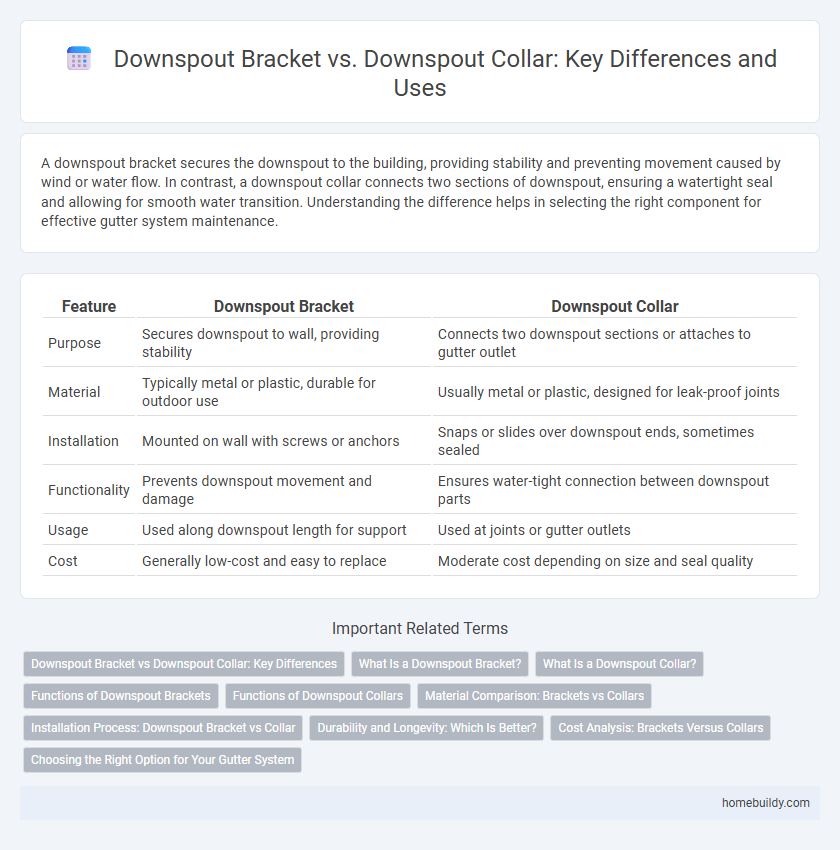A downspout bracket secures the downspout to the building, providing stability and preventing movement caused by wind or water flow. In contrast, a downspout collar connects two sections of downspout, ensuring a watertight seal and allowing for smooth water transition. Understanding the difference helps in selecting the right component for effective gutter system maintenance.
Table of Comparison
| Feature | Downspout Bracket | Downspout Collar |
|---|---|---|
| Purpose | Secures downspout to wall, providing stability | Connects two downspout sections or attaches to gutter outlet |
| Material | Typically metal or plastic, durable for outdoor use | Usually metal or plastic, designed for leak-proof joints |
| Installation | Mounted on wall with screws or anchors | Snaps or slides over downspout ends, sometimes sealed |
| Functionality | Prevents downspout movement and damage | Ensures water-tight connection between downspout parts |
| Usage | Used along downspout length for support | Used at joints or gutter outlets |
| Cost | Generally low-cost and easy to replace | Moderate cost depending on size and seal quality |
Downspout Bracket vs Downspout Collar: Key Differences
Downspout brackets and downspout collars serve distinct roles in gutter systems; brackets secure the downspout to the building, ensuring stability against weather and structural movement. Downspout collars, on the other hand, connect sections of downspout tubing or create a transition between different sizes or shapes. The key differences lie in functionality--brackets provide support and attachment, while collars facilitate joining and sealing of downspout components.
What Is a Downspout Bracket?
A downspout bracket is a secure mounting accessory designed to fasten downspouts to the exterior walls of buildings, providing stability and preventing movement caused by wind or water flow. Unlike a downspout collar, which connects sections of the downspout or seals joints to prevent leaks, the bracket primarily supports the structural alignment of the drainage system. Its durable construction and strategic placement ensure effective water drainage and protection of the building's facade from water damage.
What Is a Downspout Collar?
A downspout collar is a specialized fitting designed to securely connect and seal the joint between the downspout and the drainage pipe, preventing leaks and water damage. Unlike a downspout bracket, which primarily supports and stabilizes the downspout along the building exterior, the collar ensures a watertight transition at pipe connections. Engineered from durable materials like aluminum or vinyl, downspout collars are essential for maintaining the integrity of gutter systems by directing water flow efficiently.
Functions of Downspout Brackets
Downspout brackets securely fasten the downspout to the building structure, preventing movement and ensuring proper alignment for water drainage. Unlike downspout collars, which primarily connect sections of the downspout to maintain a watertight seal, brackets provide critical support to resist wind and impact forces. Their robust design helps maintain the integrity of the gutter system by stabilizing downspouts against building walls.
Functions of Downspout Collars
Downspout collars serve as protective sleeves that seal the joint between the downspout and gutter, preventing water leakage and debris infiltration. Unlike downspout brackets that primarily provide structural support by securing the downspout to the wall, collars maintain a watertight connection and enhance the durability of the drainage system. Their function is crucial in directing water flow efficiently while minimizing potential damage to building exteriors.
Material Comparison: Brackets vs Collars
Downspout brackets are commonly made from durable materials such as galvanized steel, aluminum, or heavy-duty plastic, providing robust support and resistance to weathering. Downspout collars, typically crafted from thinner sheet metal or rubberized materials, focus on sealing and securing joints rather than bearing weight. The choice of material significantly impacts longevity and function, with brackets favoring structural stability and collars enhancing joint tightness.
Installation Process: Downspout Bracket vs Collar
Downspout bracket installation involves securely fastening the bracket to the wall with screws or anchors, ensuring the downspout is held firmly in place to prevent movement and withstand weather conditions. In contrast, a downspout collar requires sliding the collar around the downspout joint and sealing it with adhesive or caulk to prevent leaks at the connection points. Brackets primarily provide structural support, while collars focus on sealing joints, making their installation approaches distinct yet complementary in gutter systems.
Durability and Longevity: Which Is Better?
Downspout brackets offer superior durability due to their robust metal construction, which resists corrosion and weathering better than downspout collars typically made from softer materials like plastic or aluminum. Brackets provide enhanced longevity by securely anchoring the downspout to a structure, preventing movement and potential damage from wind or debris. In contrast, downspout collars primarily serve as connectors and lack the structural strength to significantly extend the lifespan of the downspout system.
Cost Analysis: Brackets Versus Collars
Downspout brackets typically cost less than downspout collars due to simpler materials and manufacturing processes. Brackets are primarily designed for structural support, resulting in lower installation and maintenance expenses. In contrast, collars provide a sealing function which can raise the overall cost due to additional materials and labor requirements.
Choosing the Right Option for Your Gutter System
Downspout brackets provide sturdy support by securely fastening downspouts to the exterior walls, preventing movement and potential damage from wind or debris. Downspout collars are primarily used to join sections of downspouts or connect them to gutters, ensuring a watertight seal and smooth water flow. Selecting the right option depends on whether structural stability or seamless water channeling is the priority for your gutter system.
Downspout bracket vs Downspout collar Infographic

 homebuildy.com
homebuildy.com